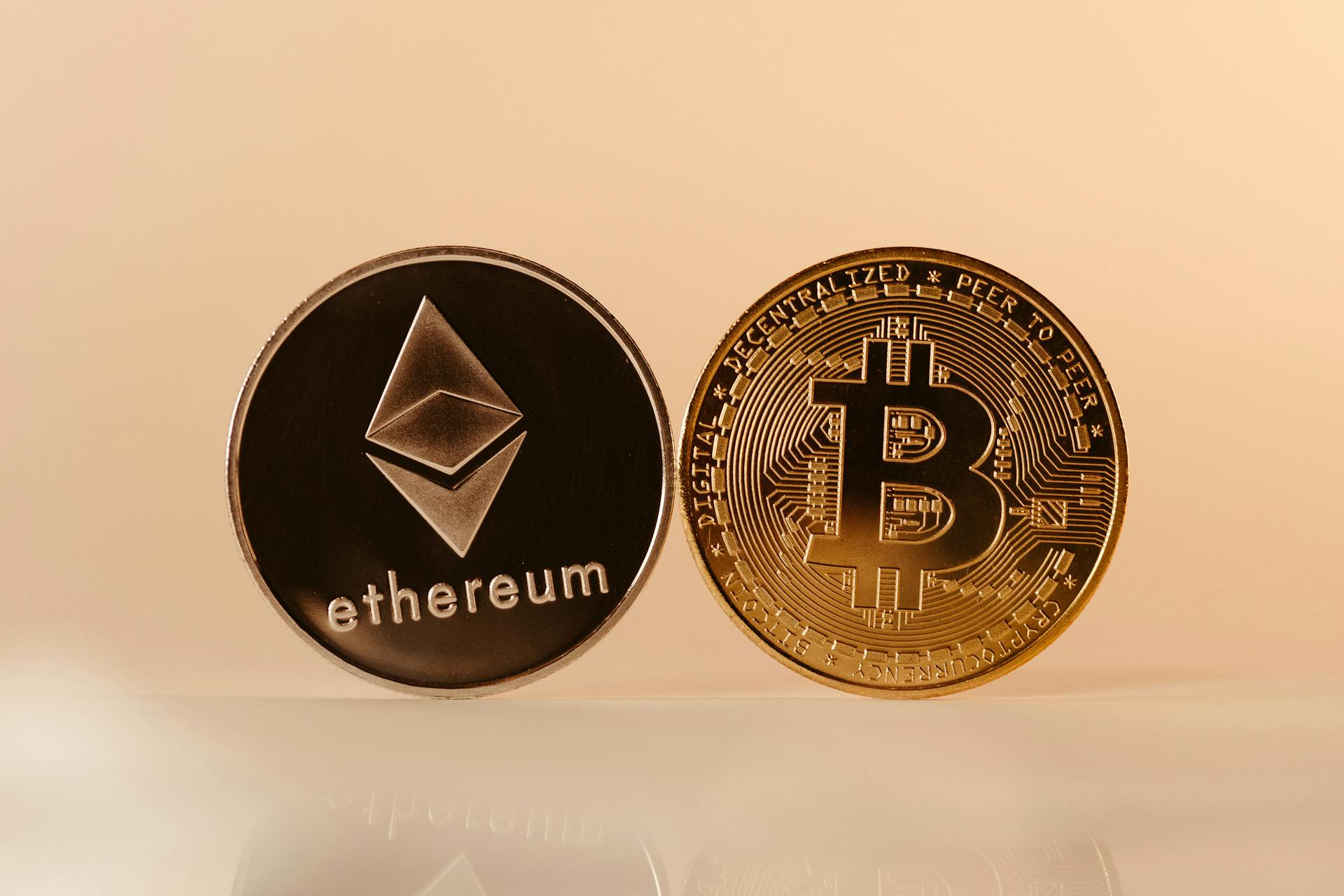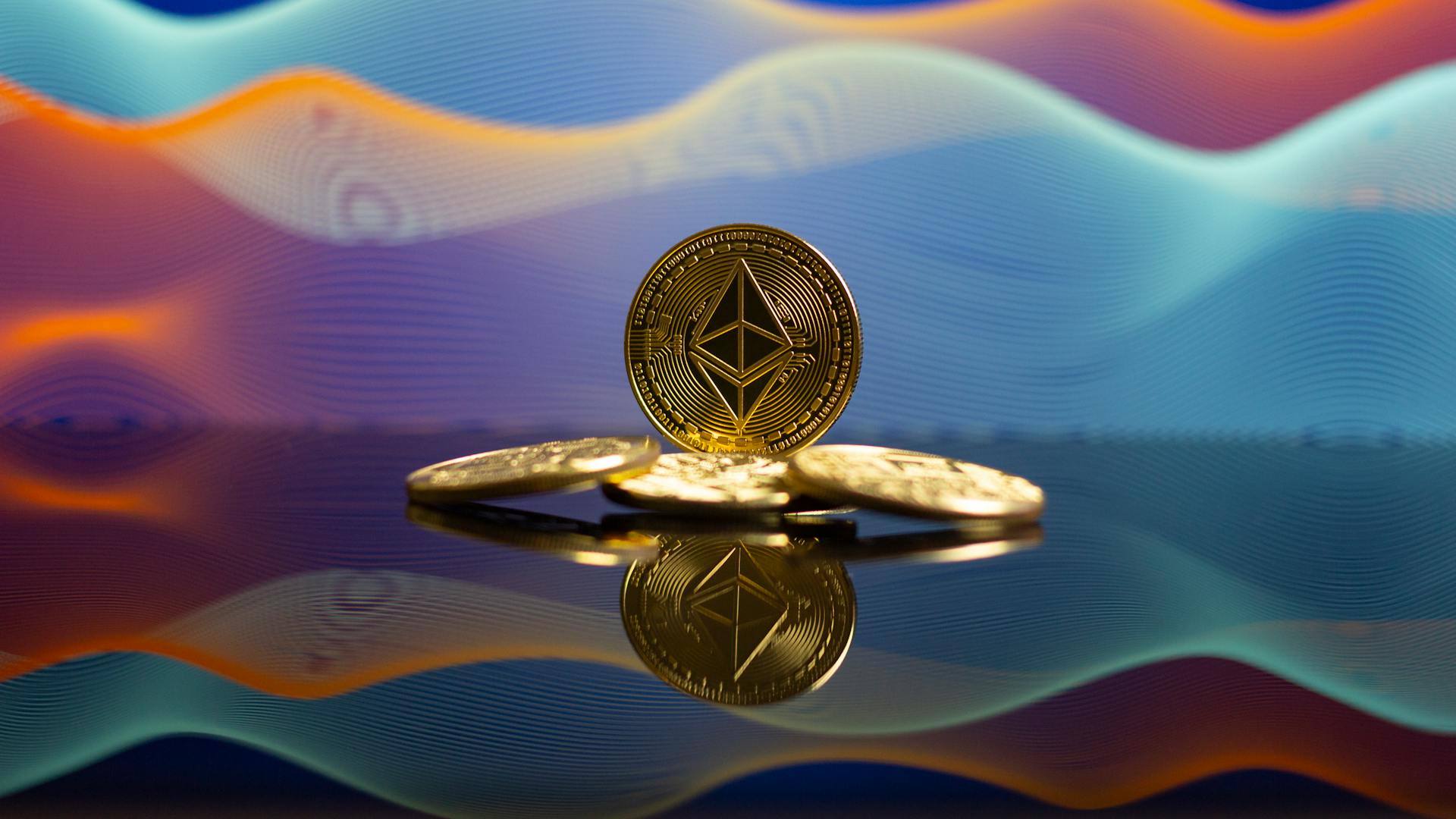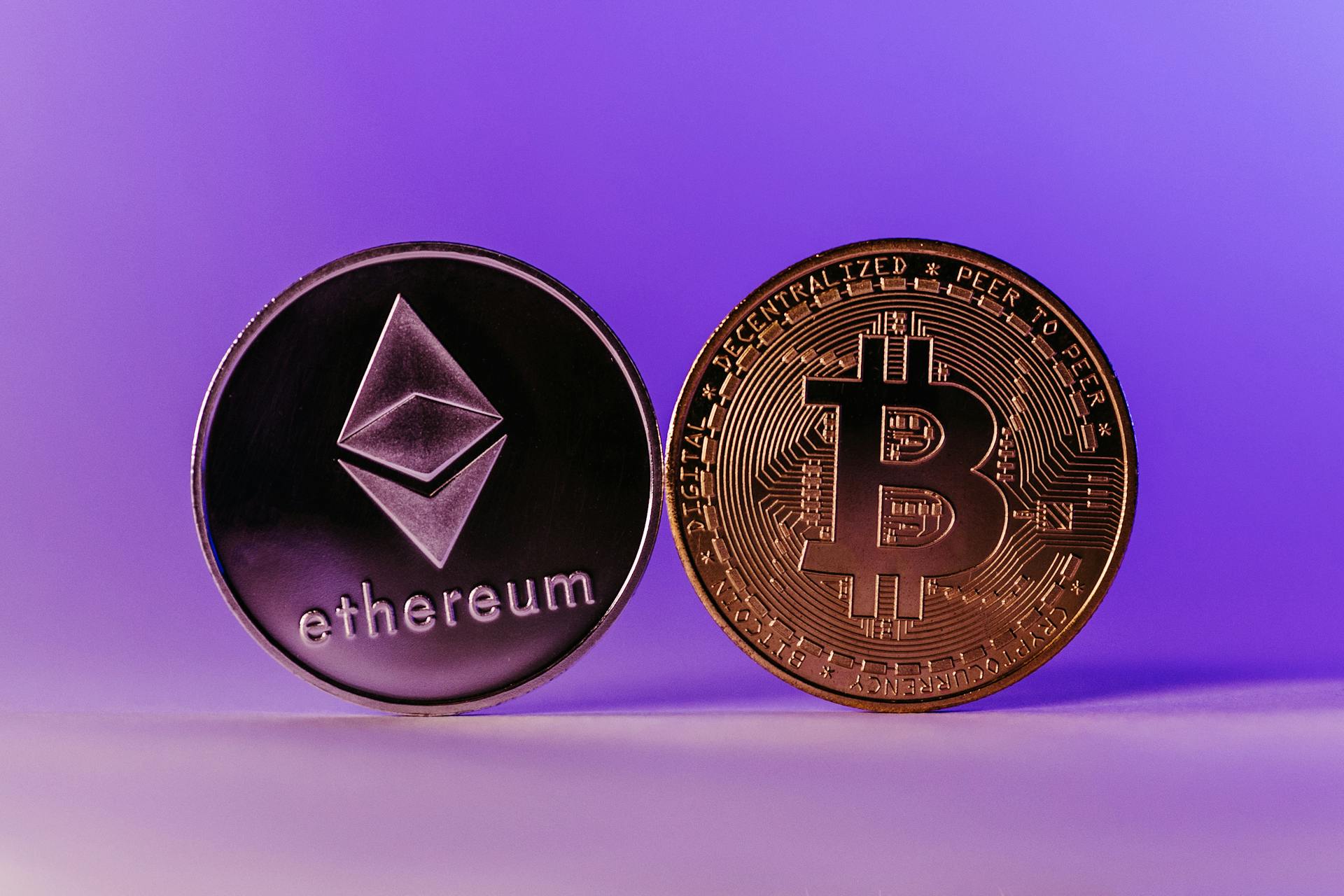
Ethereum fees have been skyrocketing in recent times, making it challenging for users to send and receive transactions. The high fees are largely due to the network's congestion, which is caused by a surge in demand for Ethereum's services.
The Ethereum network has been experiencing an unprecedented level of activity, with a significant increase in the number of transactions being processed daily. This has put a strain on the network's resources, resulting in higher fees.
As a result, users are being forced to pay more to send and receive transactions. This is not only frustrating for users but also affects the overall usability of the Ethereum network.
The high fees are also affecting the adoption of Ethereum, making it less appealing to new users.
On a similar theme: Quickest Way to Purchase Bitcoins
Calculating Ethereum Fees
Ethereum fees are calculated using a formula that takes into account the base fee, tip, and gas units. The base fee is the minimum price for gas and is determined algorithmically based on Ethereum block space demand.
See what others are reading: Gas Prices
In August 2021, Ethereum changed its calculations for gas fees to use a base fee, units of gas required, and a priority fee. The priority fee is a tip to the validator that chooses a transaction.
The formula for calculating gas fees is: (Base fee + Tip) * Gas units (limit). However, the gas limit is not always reached and is typically auto-set by wallets based on how complex they predict the transaction to be.
A more accurate formula for calculating gas fees is: Units of gas actually used * (Base fee + Tip). This is because the gas limit is not always reached, and the actual gas used may be lower than the predicted gas.
Here's a breakdown of the different types of gas fees:
- Fast: These transactions should be processed in under 30 seconds.
- Standard: A standard transaction should take less than five minutes to execute.
- Slow: For those who can wait up to 30 minutes and want to pay a cheaper gas fee, you can choose a slow transaction base gas fee.
The base fee is the minimum price for gas and is determined algorithmically based on Ethereum block space demand. The tip fee is optional but is included to get your transaction processed more quickly when network congestion leads to a backlog of orders in Ethereum's mempool.
To calculate your total fee, you multiply your base fee (and tip if you add one) by the maximum number of gas units you are willing to pay (also known as a gas unit limit or gas limit).
A fresh viewpoint: Ethereum Gas
Understanding Ethereum Fees
Ethereum fees are a way to compensate validators for their work on maintaining and securing the blockchain. This concept was introduced to incentivize miners for their work, and after the proof-of-stake algorithm was rolled out, a portion of the gas fee became the reward for staking ETH and participating in validation.
A transaction fee is similar to the fee you pay for a money wire transfer, and it's used to pay Ethereum validators for verifying and processing transactions on the network. Gas fees rise and fall with supply and demand for transactions, so if the network is congested, gas prices might be high.
Gas fees on Ethereum have utilized a base fee and a tip fee since the London Hard Fork implementation in August 2021. The base fee is the minimum price for gas and is determined algorithmically based on Ethereum block space demand. The tip fee is optional and is included to get your transaction processed more quickly when network congestion leads to a backlog of orders.
A unique perspective: Currency Conversion Fee vs Foreign Transaction Fee
Here's a breakdown of the different transaction speeds and their corresponding gas fees:
To calculate your total fee, you multiply your base fee (and tip if you add one) by the maximum number of gas units you are willing to pay. For example, if your base fee is 75 gwei, your tip is 5 gwei, and your gas limit is 30,000, your total fee would be 2,400,000 gwei, which is equivalent to 0.0024 ETH.
Consider reading: Ethereum High Gas Fee Payment
Mastering Eth with Blocknative
Blocknative offers web3's most accurate gas fee tracker, helping you avoid paying high gas prices during peak network congestion.
You can use their ETH gas browser plugin to be notified when prices fall below your specified threshold.
Blocknative's gas platform gives unmatched insights when it comes to gas prices, making it a valuable tool for traders and developers alike.
Their free Gas Estimator Browser Extension is a great resource for traders to get started with.
With Blocknative's industry-leading gas platform, you can take out the guesswork and save money on your transactions.
You might like: When Will Ethereum Etf Start Trading
Concerns About
Concerns about Ethereum gas fees are a major issue for users. Gas fees have been climbing since January 2020, reaching more than $20 for long periods.
Before 2020, gas fees were very low, measured in a few cents with occasional spikes. This made Ethereum an attractive option for users who wanted to make transactions without breaking the bank.
After The Merge, fees began to range from a few dollars to as high as $30. However, The Merge was not designed to address the problem of high fees, so users can expect fees to remain a concern.
The Merge was just one update in a series of changes aimed at eventually lowering gas fees.
Minimizing Charges
Setting a lower base fee in your wallet can result in slow, stuck, or dropped transactions. However, this might be a viable option for you if you're willing to take the risk.
Wait for periods of low activity to minimize gas fees. This can be a challenging endeavor, but it's not impossible.
Using Layer-2 solutions is one of the best ways to keep your fees low. These separate blockchains operate on top of the Ethereum network and have drastically lower gas fees.
You can use gas fee tracking tools like Blocknative Gas Estimator to get an accurate estimate of your gas fees. This can help you make informed decisions about when to send your transactions.
Here are some examples of widely-used Layer-2 scaling solutions:
- Polygon
- Optimism
- Arbitrum
EtherScan provides a gas tracker that shows the day's high, low, and average gas fees. This can help you time your necessary transactions when gas fees are low.
Check this out: Low Fee Crypto Wallet
Reducing Ethereum Fees
The high gas limit is a major contributor to high Ethereum fees, with a current limit of 12.2 million units per block, as seen in the "Gas Limit and Block Size" section. This limits the number of transactions that can be processed in a single block.
High demand for Ethereum transactions, especially during peak periods, drives up fees. The "Ethereum's Growing Popularity" section explains how Ethereum's increasing popularity has led to higher demand and subsequently higher fees.
On a similar theme: Bitcoin Atm Withdrawal Limit
To reduce Ethereum fees, you can consider using alternative blockchains like Binance Smart Chain or Solana, which have lower transaction fees. The "Alternative Blockchains" section highlights these options.
Batching transactions together can also help reduce fees, as seen in the "Transaction Batching" section. This involves grouping multiple transactions into a single transaction, reducing the number of individual transactions that need to be processed.
Using a gas price oracle can help you find the optimal gas price for your transaction, reducing fees. The "Gas Price Oracle" section explains how oracles can help you navigate the complex world of gas prices.
Limiting the number of transactions you send can also help reduce fees, as seen in the "Transaction Frequency" section. This may require some discipline, but it can be an effective way to save on fees.
You might enjoy: Ethereum Price Uk
Current Status of Ethereum Fees
Ethereum's transaction fees are indeed high right now, and it's all due to network traffic and validator availability.
The more traffic on the network, the higher the fees. This is a direct result of the increased demand for transactions, which puts a strain on the validators who process them.
As the network becomes more congested, the fees rise to incentivize validators to prioritize transactions and keep the network running smoothly.
Ethereum's high fees are not just a temporary issue, they're a result of the network's current state, which is being driven by an increase in traffic.
When Are Lowest?
Ethereum gas fees tend to be lower on weekends and during specific off-peak hours.
These periods of low activity allow you to compete with fewer users for block space, resulting in faster transaction processing times.
Gas fee calculators can help you find the cheapest times to conduct transactions, and many wallets, like MetaMask, have built-in calculators that automatically set the gas fee for you.
Ethereum's gas fee spikes have coincided with network demand exceeding its bandwidth capacity, such as during the ICO boom of 2017 and the DeFi summer of 2020.
The launch of popular NFT projects, like CryptoKitties, has also contributed to severe congestion in the Ethereum network.
Waiting for periods of low activity can significantly reduce your gas fees, and resources like the gas estimator heat map can help you plan your transactions optimally.
Generally, you can expect to pay less for gas when conducting transactions at midnight PST compared to 10:00 am PST.
Track with Blocknative
Blocknative's Gas Fee Tracking Tools can help you avoid paying high gas prices during peak network congestion.
Their ETH gas browser plugin will notify you when prices fall below your specified threshold, so you can plan your transactions accordingly.
You can also view helpful resources such as next block gas prediction, a gas heatmap, and recent gas prices to monitor and plan your transactions.
Blocknative offers web3’s most accurate gas fee tracker, giving you the best data possible to make informed decisions about your transactions.
With their tools, you can take out the guesswork and save money on gas fees.
Reasons for Increasing Ethereum Fees
Ethereum fees have been skyrocketing, and it's essential to understand the reasons behind this trend. One of the primary reasons is the rapidly increasing use of the Ethereum blockchain, which has led to a surge in gas fees.
The Ethereum blockchain has become a go-to platform for developing decentralized applications (dApps) and decentralized finance (DeFi) solutions. This increased activity has put a significant load on the network, resulting in massive growth in gas fees.
A flood of users trying to carry out transactions all at once can also cause gas fees to skyrocket. This is often seen during popular DeFi or NFT events, such as the Otherside launch by Bored Ape Yacht Club creators Yuga Labs. During this event, average gas fees hit the 6,000 gwei range as users competed to mint an Otherdeed.
Sustained interest in the Ethereum network has also historically led to higher gas prices. As more people use the network and conduct more complicated transactions, the demand for block space increases, resulting in longer periods of higher network fees. This is evident during periods of high interest in the network, such as the DeFi Summer in 2020 up to the bear market of 2022.
Related reading: What High Interest Savings Account
Here are some key factors that contribute to Ethereum gas fees:
- Increasing use of the Ethereum blockchain
- Flooding of users trying to carry out transactions at once
- Sustained interest in the Ethereum network
- Higher demand for block space
These factors have led to a significant increase in gas fees, making it essential to understand the underlying reasons and find ways to reduce them.
Limiting Ethereum Fees
Ethereum's gas limit is a crucial factor in determining transaction fees. It's set at 15 million units, which is the maximum amount of gas that can be spent in an Ethereum block.
The gas limit varies depending on the type of transaction, with basic ETH transfers having a gas limit of around 21,000 units. This is significantly lower than the overall gas limit, which indicates the block's capacity.
The gas limit is a key consideration when calculating Ethereum fees, as it determines the maximum amount of gas that can be spent on a transaction.
Curious to learn more? Check out: Gas Fees Ethereum
Ethereum Fee Basics
Gas is required of all users to carry out any function on the Ethereum network, serving as a necessary fee to prevent spamming of the network.
Each transaction needs a certain amount of computational resources to complete, which requires a gas fee.
The gas fee market is used to prioritize which transactions will be included in the next block, due to limited space in each Ethereum block.
A smaller denomination of ether, called "gwei", denotes gas prices, with one gwei equal to 0.000000001 ETH (10-9 ETH).
What Are Eth?
Eth is a cryptocurrency that's used to pay for transactions and services on the Ethereum network. One of the smallest denominations of eth is called a "gwei", which is equal to 0.000000001 ETH.
The price of eth can fluctuate, but gwei is a convenient unit of measure for gas fees. For example, a base fee of 75 gwei is a common price for gas fees.
To understand eth, it's helpful to think of it as a resource that's used to power transactions on the Ethereum network. Without eth, transactions wouldn't be possible.
Consider reading: Crypto Coin Price in India
Here are the three categories of Ethereum transaction speeds, along with their corresponding gas fee levels:
- Fast: These transactions should be processed in under 30 seconds, with a gas fee level of high.
- Standard: A standard transaction should take less than five minutes to execute, with a gas fee level of medium.
- Slow: For those who can wait up to 30 minutes and want to pay a cheaper gas fee, you can choose a slow transaction base gas fee.
The base fee is the minimum price for gas, and it's determined algorithmically based on Ethereum block space demand. This means that the base fee can change over time, depending on how much demand there is for space in Ethereum blocks.
What Is a Gwei?
A Gwei is essentially Ether's 'cents'. It's a smaller unit of measurement to understand the value of transactions.
The smallest unit of ETH is a 'wei', which represents one quintillionth of one ether.
Here's a list of different denominations of ether, showing the relationship between them:
- wei — 1
- kwei (babbage) — 1,000
- mwei (lovelace) — 1,000,000
- gwei (shannon) — 1,000,000,000
- microether (szabo) — 1,000,000,000,000
- milliether (finney) — 1,000,000,000,000,000
- ether (ETH) — 1,000,000,000,000,000,000
A Gwei is a blend of 'giga' and 'wei', where 'giga' means billion and 'wei' means one. There are one billion WEI in one GWEI.
Transaction Types
Selling an NFT on a marketplace like Uniswap is a relatively simple transaction, with gas fees likely to be just a couple of dollars.
Driving from New York City to Connecticut is a good comparison for this type of transaction.
A more complex transaction, like a DeFi operation on a dApp, requires engaging several smart contracts on the Ethereum Virtual Machine (EVM), resulting in higher gas fees.
Driving from New York City to Florida is a better comparison for this type of transaction.
Deploying a smart contract on Ethereum is a highly complex transaction, with gas fees potentially exceeding $10,000.
A unique perspective: New Crypto Coins 2023
Featured Images: pexels.com


